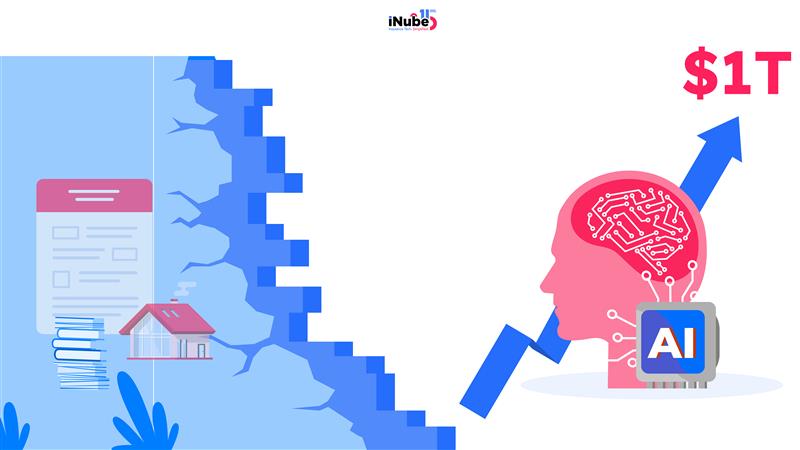The global insurance industry stands at the precipice. With the premiums reaching a whopping $1.1 trillion in personal lines, the P&C industry alone in 2022-23, and the worldwide insurance market is projected to take a hit of $7.06 trillion by 2025, the sector has never been larger- or more vulnerable to technological disruption. Artificial Intelligence isn’t just knocking on the insurance door anymore, but it’s already inside, rewiring everything from underwriting algorithms to claims processing systems, and the transformation is doing quite well in accelerating at a breakneck speed.
Amid all these, the real question will not be measured in spending, but it will be transformed into the wholesome transformation of business models, competitive dynamics, and the very definition of what insurance means in the insurance digital age.
Understanding the Current State- A Global Industry in Flux
The insurance industry in 2025 is navigating the contradictory forces. On one hand, personal lines of P&C insurance premiums essentially grew by 9.5% in 2022-23, while outpacing the global GDP by half a percentage point. However, there is a significant mask on the underlying fragility. At a global level, the insurers’ return on equity essentially reached only about 10 percent in 2024, with the estimates of 10.7% for 2025, a respectable but hardly exceptional given the risk of capital deployed. Most importantly, industry growth in the developed markets was largely driven by rate increases, which indicate the limited expansion into new risks.
These massive protection gaps do not only exist because people need insurance but also because the traditional models are not making coverage accessible, affordable, or relevant to modern lives. This is where AI- a technology with the potential to bridge gaps while fundamentally altering the industry’s economics, competitive structure, and customer relationships.
The AI Adoption Reality- Going Beyond the Hype
The headlines trumpet AI as the insurance savior; however, what actually happens on the ground is quite different. Numerous studies have shown that, as dynamic as the insurance industry is, continuous adoption is leading to an acceleration, but the implementation of challenges remain formidable.
One critical thing to understand here is that implementation does not mean transformation. While most of the insurers have deployed Gen-AI across various functions, the largest cluster still lies in the scoping stage, which suggests that after initial experiments with proof-of-concepts, the insurers can take a more measured approach to scaling.
The investment is flowing; however, the questions about ROI, Implementation, and scaling still exist.
Where AI is Making an Impact- The Use Cases that Drive Value
For years, the AI in insurance was essentially discussed as a distant promise that was more than a practical reality. However, this is no longer the case. Today, AI is not just about automating tasks, but it’s reshaping the entire value chain, changing the way insurers underwrite, price, service, and engage with customers.
However, the true impact lies in targeted, high-leverage use cases which blend data, intelligence, and human expertise:
Fraud Detection at Scale
Traditional fraud detection checks are both manual and reactive in nature. The AI will enable continuous monitoring and pattern recognition, flag anomalies in real-time, and significantly reduce the loss ratios.
Smart Underwriting
The AI models will be able to process structured as well as unstructured data, which essentially includes everything from medical records to IoT signals for delivering real-time risk assessments. This has not only sped up the onboarding but has also enabled hyper-personalized products.
Claims Automation
The NLP and computer vision are significantly powering up the straight-through claims processing, which is turning the process that once took weeks into just a matter of minutes. This has led to a significant improvement for both insurers to enhance their operational efficiency and also the policyholder’s experience.
Customer Engagement
The AI-driven chatbots and virtual assistants are no longer just basic FAQ tools. Instead, they now offer context-aware conversations, helping the customers to compare products,
file claims and also manage policies without any human intervention.
Predictive Analytics for Retention
By seamlessly spotting the early churn signals, AI effortlessly empowers the insurers to act proactively, tailor the retention strategies, and also the offers that keep the customers engaged.
A Peek at the Barriers- Why Most Insurers Struggle
Despite the promise of AI, most of the insurers remain stuck in what the industry observers essentially call “pilot purgatory”. This means running small experiments that demonstrate feasibility but also fail to deliver enterprise-wide transformation.
Here’s a look at the challenges that insurers face:
Legacy infrastructure and Technical Debt
Most of the insurers still operate on the systems which are built decades ago, and this essentially includes mainframes running COBOL code, monolithic architecture, and also the ones that cannot communicate with the modern applications and databases that are structured around paper-based workflows that have been digitized, but they were never truly reimagined.
The problem here is not just about cost; instead, it’s about compatibility. The AI models need access to clean, integrated data, which will flow in real-time. The legacy systems were designed for batch processing, siloed data storage, and human-mediated workflows. By connecting AI to these systems, it will be like trying to plug a quantum computer into a telegraph line, which will technically be possible but is also fundamentally mismatched.
Data Quality and Governance Challenges
The data readiness will essentially be a critical challenge for most of the insurers in 2025, along with some organizations that still struggle with the fragmented or incomplete data. This fragmentation and incomplete data make it difficult to fully leverage the AI’s potential. One important thing that every insurer needs to know is that AI is only as good as the data that it learns from.
Additionally, robust governance and the cleaning processes are extremely essential to maximize the AI’s potential, and the insurance industry’s stringent data privacy regulations require careful navigation to avoid any legal penalties.

Archismita Mukherjee
Insurance Content Analyst


